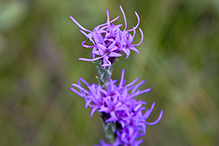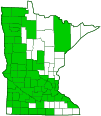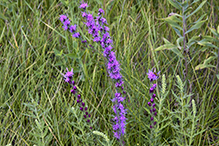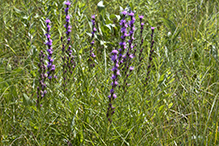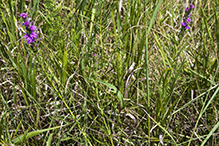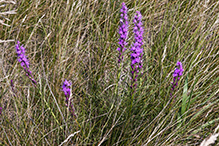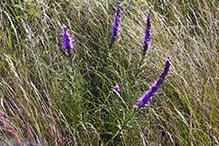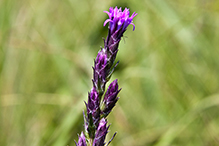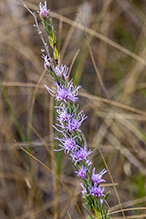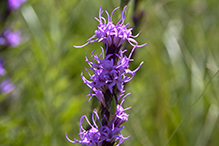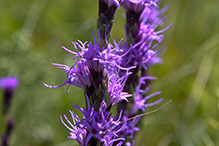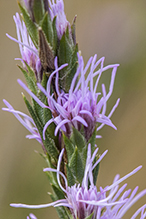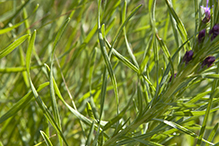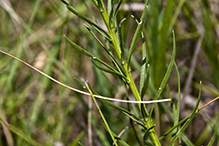dotted blazing star
(Liatris punctata var. punctata)
Conservation • Description • Habitat • Ecology • Use • Distribution • Taxonomy
Conservation Status |
|
|||||||
| IUCN Red List | not listed |
|||||||
| NatureServe | N5 - Secure SNR - Unranked |
|||||||
| Minnesota | not listed |
|||||||
Description |
||
Dotted blazing star is a 8″ to 16″ tall, erect, long-lived, perennial forb that rises on one to several stems from a corm. The corm is vertical, thickened, elongated, tapered, and pointed at the end, resembling a taproot. Occasionally it becomes a somewhat horizontally spreading rhizome. In the first year it appears as a rosette of basal leaves and develops an elongated, taproot-like corm up to 35″ deep. In subsequent years it sends up an aerial stem and the rootstock grows deeper, eventually reaching as much as 16.4′ in deep soils. The stems are erect, very leafy, and hairless. They are not covered with glands. Basal leaves form a rosette. Stem leaves are alternate but may be so closely spaced that they appear whorled, especially near the base. Basal and lower stem leaves are short-stalked, linear, 4″ to 5½″ long, and up to ¼″ wide. The lowermost stem leaves are small and somewhat sheath the stem. They are smaller than those above and are usually absent at flowering time. The largest leaves are immediately above those. The upper and lower surfaces are grayish-green, hairless, and densely covered with translucent, sunken, resin glands. There is a single prominent midvein and no visible parallel veins. The margins are light, thickened, untoothed, and often turned under. At least some of the leaves have a moderate to dense fringe of hairs. The hairs break off with age leaving a minute, stubby base. Middle and upper stem leaves are similar, ascending, stalkless, and ⅝″ to 4¾″ long, becoming gradually smaller as they ascend the stem. The inflorescence is a dense, leafy, unbranched, elongated, up to 12″ long, spike-like cluster of up to 24 flower heads at the end of the stem. The flower heads are closely spaced and stalkless or almost stalkless. Each flower head is subtended by a single leaf-like bract. The axis of the inflorescence is mostly not visible between the heads. The flower heads are about ½″ wide and ½″ to ¾″ long. The terminal head is sometimes slightly longer than the others. The whorl of bracts at the base of the flower head (involucre) is narrowly cup-shaped to nearly cylinder-shaped, and ⅜″ to 9 ⁄16″ long. The bracts making up the involucre are in usually 4, sometimes 5, overlapping series. They are mostly oblong inversely egg-shaped. They taper to a sharp point at the tip. The tips are ascending or somewhat spreading. The outer surface is covered with translucent, sunken, resin glands. The margins have a fringe of cobwebby hairs. There are 4 to 8 disk florets and no ray florets. Each disk floret has 5 petals fused for most of their length into a tube then separated at the tip into 5 lobes. The corolla tube is white at the base grading to pink at the tip. There are 5 stamens concealed within the corolla tube and a long, white, forked style that protrudes well beyond the tip of the corolla tube. There is no fragrance. The fruit is a dry achene (cypsela) with bristles attached. The bristles are feather-like (plumose), though this may be difficult to see without a hand lens. |
||
Height |
||
Up to 16″ |
||
Flower Color |
||
Pink |
||
Similar Species |
||
|
||
Habitat |
||
Dry. Sandy soil. Prairies, meadows, open places. |
||
Ecology |
||
Flowering |
||
July to September |
||
Pests and Diseases |
||
|
||
Use |
||
|
||
Distribution |
||||
|
Sources |
|||
| 4/6/2023 | ||||
Nativity |
||||
Native |
||||
Occurrence |
||||
|
||||
Taxonomy |
|||
| Kingdom | Plantae (Plants) | ||
| Division | Tracheophyta (Vascular Plants) | ||
| Subdivision | Spermatophytina (Seed Plants) | ||
| Class | Magnoliopsida (Dicots) | ||
Order |
Asterales (Sunflowers, Bellflowers, Fanflowers, and Allies) | ||
Family |
Asteraceae (Sunflowers, Daisies, Asters, and Allies) | ||
| Subfamily | Asteroideae | ||
| Supertribe | Helianthodae | ||
| Tribe | Eupatorieae (bonesets, blazingstars, and allies) | ||
| Subtribe | Liatrinae | ||
Genus |
Liatris (blazing stars) | ||
| Species | Liatris punctata (dotted blazing star) | ||
Subordinate Taxa |
|||
|
|||
Synonyms |
|||
| Liatris punctata var. nebraskana | |||
Common Names |
|||
dotted blazing star dotted gayfeather |
|||
Glossary
Achene
A dry, one-chambered, single-seeded seed capsule, formed from a single carpel, with the seed attached to the membranous outer layer (wall) only by the seed stalk; the wall, formed entirely from the wall of the superior ovary, does not split open at maturity, but relies on decay or predation to release the contents.
Bract
Modified leaf at the base of a flower stalk, flower cluster, or inflorescence.
Corm
A short, solid, vertical, thickened, underground stem that serves as a storage organ.
Cypsela
A dry, one-chambered, single-seeded fruit, formed from a single carpel, with the seed attached to the membranous outer layer (wall) only by the seed stalk; the wall, formed from the wall of the inferior ovary and also from other tissues derived from the receptacle or hypanthium, does not split open at maturity, but relies on decay or predation to release the contents.
Involucre
A whorl of bracts beneath or surrounding a flower, flower head, or flower cluster.
Linear
Long, straight, and narrow, with more or less parallel sides, like a blade of grass.
Plumose
Feathery; having fine, pinnately arranged, lateral bristles or hairs arranged on both sides of an axis.
Rhizome
A horizontal, usually underground stem. It serves as a reproductive structure, producing roots below and shoots above at the nodes.


Visitor Videos |
|||
Share your video of this plant. |
|||
| This button not working for you? Simply email us at info@MinnesotaSeasons.com. Attach a video, a YouTube link, or a cloud storage link. |
|||
Other Videos |
|||

Visitor Sightings |
|||||
Report a sighting of this plant. |
|||||
| This button not working for you? Simply email us at info@MinnesotaSeasons.com. Be sure to include a location. |
|||||
|
|||||
MinnesotaSeasons.com Sightings |
|||||
Felton Prairie SNA, Bicentennial Unit Margherita Preserve-Audubon Prairie Mound Spring Prairie SNA, North Unit Mound Spring Prairie SNA, South Unit Northern Tallgrass Prairie NWR, Hoffman Unit Pankratz Memorial Prairie, North Unit Pembina Trail Preserve SNA, Crookston Prairie Unit Pembina Trail Preserve SNA, Pembina Trail Unit Sand Prairie Wildlife Management and Environmental Education Area |
|||||

|
Created: Last Updated: © MinnesotaSeasons.com. All rights reserved. |
